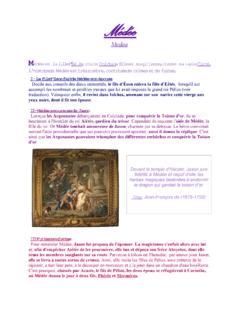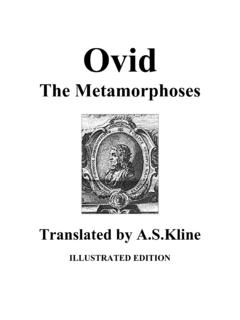Transcription of Steam Engineering Basics - John Forester
1 John Forester , , 7585 Church St., Lemon Grove, CA 91945-2306. 619-644-5481 Wednesday, May 28, 2008. Marine Steam Engineering Basics for Touring the Steam Ships Berkeley and Medea of the San Diego Maritime Museum 1 Steam Properties Railroad. After twenty-six years of service, the two Scotch boilers were replaced by the present four Our Steam Engine Plants watertube boilers. Steam engines work by using the expansion The Steam Engine System of high-pressure Steam to push against moving pistons in the cylinders of reciprocating engines, The Steam engine plant consists of far more or against the moving vanes of Steam turbines. than the Steam engine itself. The water and Steam When the Berkeley and the Medea were built, run through a continuous cycle of water boiled into Steam piston engines, after a century of develop- Steam , used in the engine, condensed back to ment, were universal for marine use, and they water, and then pumped back into the boiler for continued up through the Liberty Ships of World reuse, a cycle first studied scientifically by the War II that deliberately used an old design that French engineer Sadi Carnot in 1824, about a was easy to century after the first Steam engines had been Change was coming.
2 In the year that Berke- built. ley was being designed, an experimental turbine- Therefore, the complete Steam plant consists powered vessel sneaked into the British Navy's of a furnace in which to burn the fuel, the boiler in parade for Queen Victoria's Golden Jubilee, and which the heat from the furnace is used to boil outran Britain's fastest destroyers. Ten years later, water into Steam , the Steam engine which turns the Diesel engine came into marine use, at first for the heat of the Steam into mechanical power, the small vessels, so that nowadays ships are pow- condenser which condenses the Steam back into ered either by turbines ( Steam or gas) or by die- water, and the feed pump that pumps the water sels. The Steam reciprocating engine, nowadays, back into the boiler. We will look at each of these is just a historical artifact, but it represented the machines, but first you must learn a little about very best that the technology of the time could water and Steam .
3 Produce. The Berkeley's Steam engine and boilers are Water and Steam typical of almost the highest development of the marine reciprocating piston engine, the three cyl- The Temperature Cycle and Efficiency indered triple-expansion engine supplied with Carnot showed that the possible efficiency of Steam from the oil-fired straight watertube boilers. any heat engine depends on the temperature dif- The Medea's Steam engine and boiler, although ference between the highest and the lowest tem- built six years later, are typical of the previous peratures of the working fluid, the water and the generation of Steam plants, the two-cylindered Steam in our ships, divided by the highest temper- compound double-expansion engine supplied with ature. The greater the temperature range, and the Steam from a firetube boiler, originally burning hotter the highest temperature, the more power coal but since converted to oil.
4 Produced for the fuel burned. The highest temper- The Berkeley was originally equipped with ature is limited by the strength of the materials two firetube Scotch boilers, burning coal, similar in from which the boiler, Steam pipes, and engine are principle to the boiler of the Medea but different in made. In the highest development of the piston design. After two years of service, the Berkeley Steam engine, the limit was set by the lubricating was converted to oil, the same fuel used by the oil for the valve and piston; the Steam was so hot locomotives of her owner, the Southern Pacific that even special thick oil ran like water, but the 1. 2 Steam Engineering Basics Berkeley never approached those temperatures. push the air away and fill the space with Steam . If Her maximum Steam temperature was about the space is enclosed, as in a pressure cooker or 425 F.
5 The lowest usable temperature is that of a boiler, this increases the pressure. If the pres- the surroundings. There's no point in making a sure is increased, then it is more difficult for the lower temperature, as in a refrigerator, because it water molecules to jump into the gas, the Steam , costs much more energy to make the cold than and take up more space, and some go slow you could get by using that cold. (That's also enough to be captured again into the water. explained by the Carnot cycle, for a refrigerator is Therefore, for every pressure there is a tem- a heat engine run in reverse.) However, since a perature at which water and Steam can exist ship floats in an infinite supply of cold water, the together. Contrariwise, for each temperature, temperature of the seawater is the lowest temper- there is a pressure at which water and Steam can ature we can use.
6 With the temperature range that exist together. the Berkeley used, the theoretical efficiency could The Steam engine designer always works in be no higher than about 30%. Probably, only absolute pressure, starting from zero pressure, as about 10% or 15% of the energy in the fuel could in the vacuum of outer space. This means that be actually used in driving the ship. sea-level pressure is 15 psia, meaning pounds per square inch absolute. You must always remember Boiling Temperature that we exist at 15 psia. (The operating engineer Now that you have learned that the engine considers ambient pressure to be zero. Thus his must work between the highest usable tempera- Steam pressure gauges read pressure above ture and the lowest obtainable temperature, you ambient, or 15 psi less than the absolute pres- need to know the properties of water and Steam sure, and he measures pressure that is lower than between those temperatures.)
7 You probably know ambient in inches of mercury of vacuum, which that when water boils into Steam it gets much you will see on the gauges in the engineroom. 30. larger, occupies much more space or volume. You inches of vacuum is substantially equal to zero probably also know that the air pressure around pressure.). you at sea level is about 15 pounds per square Here is a short table of Steam pressures, inch. You probably all know that the boiling tem- temperatures, and volumes. perature of water into Steam is 212 F, and some of you know that if you go to higher altitudes, where the air pressure is lower, water boils at a Table 1: Steam Characteristics lower temperature, making cooking slower, while if you confine the Steam in a pressure cooker the Pressure, Boiling temperature goes up to make cooking quicker. Volume, Pounds per Temperature There is an easy explanation for this.
8 As Cubic Feet Square Inch, Degrees water, the molecules are very close together, per Pound sticking together in fact, although they slip past Absolute Fahrenheit each other, roll over each other, with little friction, making water a liquid. As Steam , the same mole- 1 102 335. cules rush about independently of each other, tak- 2 126 174. ing up much more space and making Steam a gas, just like any other gas. 5 162 73. Temperature really refers to the speed with which the molecules of water are moving. At room 10 193 38. pressure, very few of the molecules move fast enough to jump into the air against the pressure of 15 213 26. the air and take up much more space as cold Steam , or water vapor, or humidity, whatever you 20 228 20. want to call it. That's room-temperature evapora- tion. As temperature increases, more and more of 40 267 the molecules of water get fast enough to make 60 293 the jump between the liquid and the gas against the pressure of the gas.
9 At boiling temperature, 80 312 enough of the molecules are going fast enough to Steam Engineering Basics 3. Table 1: Steam Characteristics showed that it was important to have as good a vacuum as possible as the lowest pressure in the Pressure, Boiling system. Volume, Pounds per Temperature Cubic Feet Multiple Expansion Cylinders Square Inch, Degrees per Pound You have learned the relationship between Absolute Fahrenheit the temperature and the pressure of Steam for 100 328 containers in which both Steam and water exist together. This is called wet Steam , because if the 120 341 temperature drops at all, some of the Steam con- denses into a fog of water droplets. For the 140 353 moment, consider that the engine is running on wet Steam direct from the boiler. 160 363 Suppose that the boiler Steam is at 180 psia, which is approximately the pressure in the Berke- 180 373 ley's boilers, and 373 F (assuming wet Steam for 200 382 this discussion).
10 This Steam could be allowed to fill a cylinder, pushing its piston all the way down, and doing a lot of work. However, when it was time for When considering the volume of a pound of the piston to come back up the cylinder, the Steam Steam , consider that a pound of water has a vol- would have to be allowed to escape from 180 psia ume of only cubic feet. Therefore, even at and 373 F into either the atmosphere or into the 200 psia, when water turns into Steam , its volume condenser. That would waste much of the energy increases by about 14 times. that the boiler had worked so hard to put into the You can see that if you can use the cold sea- Steam . water as the lowest temperature, say 60 F, the Instead of wasting that energy, only a small pressure would be less than 1 psia, and 1 pound amount of Steam is allowed into the cylinder at the of Steam would require more than 340 cubic feet top of the piston stroke.







